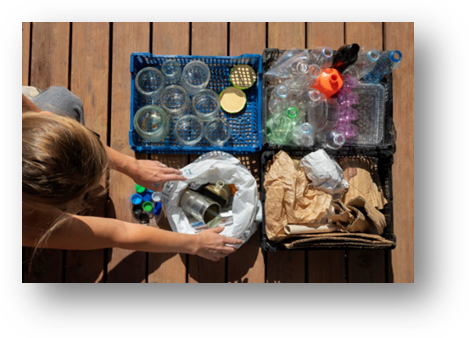1. CONTEXT
For a long time, people believed that recycling was the best thing to do with waste to protect the environment. They were not completely wrong because there are benefits, as recycling creates jobs and reduces the waste that pollutes landfills, incinerators reduce the need to devote land and resources to traditional waste disposal methods, also reducing the energy used to manufacture goods and raising overall environmental consciousness.
However, there are also some cons to using recycling as an ecological method because recycling consumes energy, can lead to pollution, is costly and gives a sense to people that they are already doing everything they can do regarding waste, leading to excessive consumption.
People need to change their mindset by using other ways to be more eco-friendly, such as reducing consumption and reusing products giving waste a second life.
That is the aim of the Circular Economy (CE). CE is a strategic concept based on the reduction, reuse, recovery and recycling of materials and energy, replacing the end-of-life concept of the linear economy with new circular flows of reuse, restoration, and renovation, in an integrated process.
This way, waste – any substance discarded after primary use, which is worthless, defective, or considered of no use – can have a second life and be considered a resource. Waste as a resource is easily accessible, economically feasible and can help to satisfy human needs and wants more sustainably than by using raw materials.

https://br.freepik.com/fotos-gratis/pessoa-fazendo-reciclagem-seletiva-de-lixo_18955505.htm
Statistics
In 2020, the total waste generated in the European Union (EU) by all economic activities and households amounted to 2151 million tonnes or 4808 kg per capita.
Construction contributed 37.1% of the total and was followed by mining and quarrying (23.4%), manufacturing (10.9%), waste and water services (10.7%) and households (9.5%); the remaining 8.4% was waste generated from other economic activities, mainly services (4.5%) and energy (2.3%).
From this, some 2029 million tonnes of waste were treated in the EU. This does not include exported waste but includes the treatment of waste imported into the EU. The reported amounts are therefore not directly comparable with those on waste generation.
During the period 2004-2020 the quantity of waste recovered – in other words, recycled – used for backfilling (the use of waste in excavated areas for slope reclamation or safety or engineering purposes in landscaping) or incinerated with energy recovery grew by 40.3 %, from 870 million tonnes in 2004 to 1221 million tonnes in 2020. As a result, the share of such recovery in total waste treatment rose from 45.9% in 2004 to 60.2% in 2020. The quantity of waste subject to disposal decreased from 1027 million tonnes in 2004 to 808 million tonnes in 2020, which was a decrease of 21.3%. The share of disposal in total waste treatment decreased from 54.1% in 2004 to 39.8% in 2020.
As stated above, in the EU, in 2020, more than half (60.2 %) of the waste was treated in recovery operations: recycling (39.2 % of the total treated waste), backfilling (14.6 %) or energy recovery (6.4 %). The remaining 39.8% was either landfilled (31.3%), incinerated without energy recovery (0.5%) or disposed of otherwise (8.1%).
However, the EU still must find ways to manage in a better way the 39.8% that was landfilled. Everyone is responsible for this, but especially organisations, as they produce higher amounts of waste, having a higher impact on waste production.

 Español
Español Turkish
Turkish български
български Magyar
Magyar Polski
Polski Português
Português